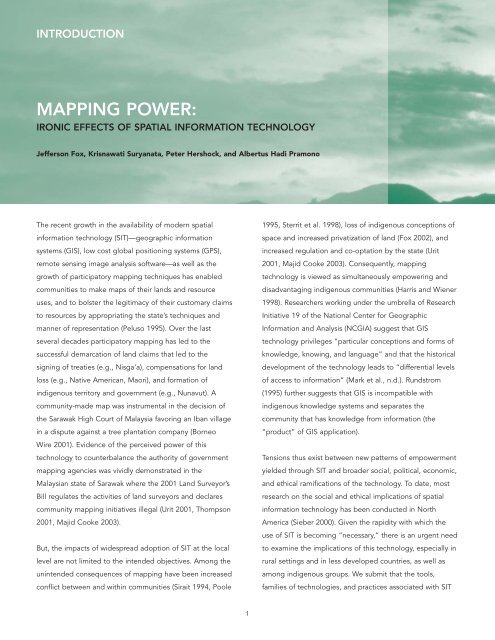FoxHershockMappingCommunities
FoxHershockMappingCommunities
FoxHershockMappingCommunities
You also want an ePaper? Increase the reach of your titles
YUMPU automatically turns print PDFs into web optimized ePapers that Google loves.
INTRODUCTION<br />
MAPPING POWER:<br />
IRONIC EFFECTS OF SPATIAL INFORMATION TECHNOLOGY<br />
Jefferson Fox, Krisnawati Suryanata, Peter Hershock, and Albertus Hadi Pramono<br />
The recent growth in the availability of modern spatial<br />
information technology (SIT)—geographic information<br />
systems (GIS), low cost global positioning systems (GPS),<br />
remote sensing image analysis software—as well as the<br />
growth of participatory mapping techniques has enabled<br />
communities to make maps of their lands and resource<br />
uses, and to bolster the legitimacy of their customary claims<br />
to resources by appropriating the state’s techniques and<br />
manner of representation (Peluso 1995). Over the last<br />
several decades participatory mapping has led to the<br />
successful demarcation of land claims that led to the<br />
signing of treaties (e.g., Nisga’a), compensations for land<br />
loss (e.g., Native American, Maori), and formation of<br />
indigenous territory and government (e.g., Nunavut). A<br />
community-made map was instrumental in the decision of<br />
the Sarawak High Court of Malaysia favoring an Iban village<br />
in a dispute against a tree plantation company (Borneo<br />
Wire 2001). Evidence of the perceived power of this<br />
technology to counterbalance the authority of government<br />
mapping agencies was vividly demonstrated in the<br />
Malaysian state of Sarawak where the 2001 Land Surveyor’s<br />
Bill regulates the activities of land surveyors and declares<br />
community mapping initiatives illegal (Urit 2001, Thompson<br />
2001, Majid Cooke 2003).<br />
But, the impacts of widespread adoption of SIT at the local<br />
level are not limited to the intended objectives. Among the<br />
unintended consequences of mapping have been increased<br />
conflict between and within communities (Sirait 1994, Poole<br />
1995, Sterrit et al. 1998), loss of indigenous conceptions of<br />
space and increased privatization of land (Fox 2002), and<br />
increased regulation and co-optation by the state (Urit<br />
2001, Majid Cooke 2003). Consequently, mapping<br />
technology is viewed as simultaneously empowering and<br />
disadvantaging indigenous communities (Harris and Wiener<br />
1998). Researchers working under the umbrella of Research<br />
Initiative 19 of the National Center for Geographic<br />
Information and Analysis (NCGIA) suggest that GIS<br />
technology privileges “particular conceptions and forms of<br />
knowledge, knowing, and language” and that the historical<br />
development of the technology leads to “differential levels<br />
of access to information” (Mark et al., n.d.). Rundstrom<br />
(1995) further suggests that GIS is incompatible with<br />
indigenous knowledge systems and separates the<br />
community that has knowledge from information (the<br />
“product” of GIS application).<br />
Tensions thus exist between new patterns of empowerment<br />
yielded through SIT and broader social, political, economic,<br />
and ethical ramifications of the technology. To date, most<br />
research on the social and ethical implications of spatial<br />
information technology has been conducted in North<br />
America (Sieber 2000). Given the rapidity with which the<br />
use of SIT is becoming “necessary,” there is an urgent need<br />
to examine the implications of this technology, especially in<br />
rural settings and in less developed countries, as well as<br />
among indigenous groups. We submit that the tools,<br />
families of technologies, and practices associated with SIT<br />
1



